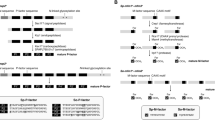Abstract
In the phytopathogenic basidiomycete Ustilago maydis mating and dikaryon formation are controlled by a pheromone/receptor system and the multiallelic b locus. Recently, a gene encoding a G protein α subunit, gpa3, was isolated and has subsequently been implicated in pheromone signal transduction. Mutants deleted for gpa3 are sterile and nonpathogenic, and exhibit a morphology that is similar to that of mutants with defects in the adenylate cyclase gene uac1. We have found that the sterility and mutant morphology of gpa3 deletion strains can be rescued by exogenous cAMP. In these mutants and in the corresponding wild-type strains, exogenous cAMP stimulates pheromone gene expression to a level comparable to that seen in the pheromone-stimulated state. In addition, we demonstrate that uac1 is epistatic to gpa3. We conclude that Gpa3 controls the cAMP signalling pathway in U.maydis and discuss how this pathway feeds into the pheromone response.
Similar content being viewed by others
Author information
Authors and Affiliations
Additional information
Received: 4 May 1998 / Accepted: 24 July 1998
Rights and permissions
About this article
Cite this article
Krüger, J., Loubradou, G., Regenfelder, E. et al. Crosstalk between cAMP and pheromone signalling pathways in Ustilago maydis . Mol Gen Genet 260, 193–198 (1998). https://doi.org/10.1007/s004380050885
Issue Date:
DOI: https://doi.org/10.1007/s004380050885




